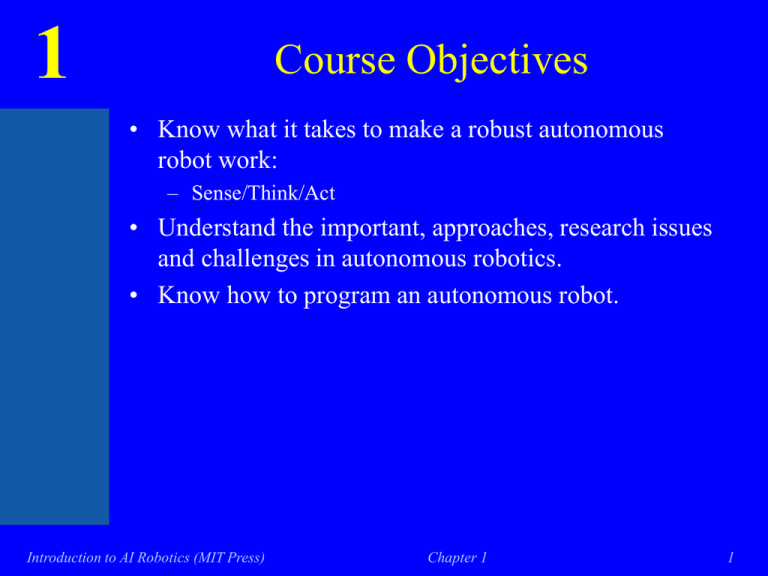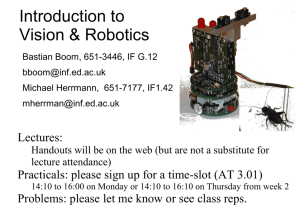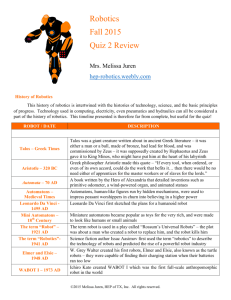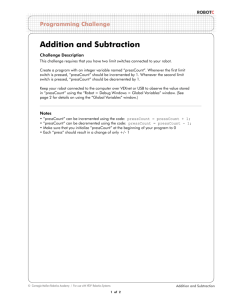Week01
advertisement

1 Course Objectives • Know what it takes to make a robust autonomous robot work: – Sense/Think/Act • Understand the important, approaches, research issues and challenges in autonomous robotics. • Know how to program an autonomous robot. Introduction to AI Robotics (MIT Press) Chapter 1 1 1 What Can Robots Be Used For? • • • • • • • • Manufacturing 3 Ds – Dirty – Dull – Dangerous Space – Satellites, probes, planetary landers, rovers Military Agriculture Construction Entertainment Consumer? Introduction to AI Robotics (MIT Press) Chapter 1 2 1 History of Intelligent Robotics • 1940s – First remote manipulators for hazardous substances • 1950s – Industrial manipulators: “reprogrammable and multi-functional mechanism designed to move materials, parts, tools…” – Closed loop control Introduction to AI Robotics (MIT Press) Chapter 1 3 1 History Continued • 1955 – term “AI” coined • 1960s manufacturing robots – Automatic guided vehicles (AGVs) – Precision, repeatability – Emphasis on mechanical aspects • 1970s – Planetary landers – Machine vision research expands • 1980s – Black factory – First intelligent autonomous robots: • Shakey, Stanford Cart, etc Introduction to AI Robotics (MIT Press) Chapter 1 4 1 History Continued • 1990s – Symbolic AI/Robotics stalls – Reactive/Behavior-based robotics emerges • 2000s – ? Introduction to AI Robotics (MIT Press) Chapter 1 5 1 Intelligent Robot • Mechanical creature which can function autonomously – Mechanical= built, constructed – Creature= think of it as an entity with its own motivation, decision making processes – Function autonomously= can sense, act, maybe even reason; doesn’t just do the same thing over and over like automation Introduction to AI Robotics (MIT Press) Chapter 1 6 1 “Intelligent” Robotics • Basic robot primitives : Sense/Think/Act • Three paradigms (architectures): - Hierarchical (Deliberative): Sense ->Plan ->Act ; - Reactive: Sense -> Act; - Hybrid (Deliberative/Reactive): Plan -> Sense -> Act Introduction to AI Robotics (MIT Press) Chapter 1 7 1 Ways of Controlling a Robot • “RC-ing” – – – – you control the robot you can view the robot and it’s relationship to the environment ex. radio controlled cars, bomb robots operator isn’t removed from scene, not very safe • teleoperation – you control the robot – you can only view the environment through the robot’s eyes – don’t have to figure out AI • semi- or full autonomy – – – – you might control the robot sometimes you can only view the environment through the robot’s eyes ex. Sojouner with different modes human doesn’t have to do everything Introduction to AI Robotics (MIT Press) Chapter 1 8 1 Teleoperation • Human controls robot remotely – Hazardous materials – Search and rescue – Some planetary rovers • Considerations – Feedback (video, tactile, smell?) – User interfaces (cognitive fatigue, nausea) – Time/distance Introduction to AI Robotics (MIT Press) Chapter 1 9 Components of a Telesystem (after Uttal 89) 1 • Local – display – Local control device • Communication • Remote – – – – sensor mobility effector power Remote Local Display Communication Sensor Mobility Control Effector Power Introduction to AI Robotics (MIT Press) Chapter 1 10 1 Example Remote Local Introduction to AI Robotics (MIT Press) Chapter 1 11 1 Introduction to AI Robotics (MIT Press) Typical Run Chapter 1 12 1 Problems that You Saw • no feedback, couldn’t really tell that the robot was stuck but finally got free – robot doesn’t have “proprioception” or internal sensing to tell you what the flippers were doing. No crunching noises, no pose widget to show the flippers • no localization, mapping-> no idea how far traveled • partial solution: better instrumentation (but can’t do dead reckoning well) – operator doesn’t have an external viewpoint to show itself relative to the environment • solution: two robots, one to spot the other • communications dropout, even though ~3 meters away • lighting conditions went from dark to very bright – hard for computer vision or human to adjust Introduction to AI Robotics (MIT Press) Chapter 1 13 1 DarkStar+7 seconds=DarkSpot • 7 second communications lag (satellite relay) • “interruption” lag on part of operator Introduction to AI Robotics (MIT Press) Chapter 1 14 1 Predator: ~7:1 human to robot ration Leo’s unofficial Predator page • 4 people to control it (52-56 weeks of training) – one for flying – two for instruments – one for landing/takeoff • plus maintenance, sensor processing and routing • lack of self-awareness– in Kosovo, come along side in helicopter and shoot down Introduction to AI Robotics (MIT Press) Chapter 1 15 1 Teleop Problems • • • • • cognitive fatigue communications dropout communications bandwidth communications lag too many people to run one robot Introduction to AI Robotics (MIT Press) Chapter 1 16 1 Telesystems Best Suited For: • the tasks are unstructured and not repetitive • the task workspace cannot be engineered to permit the use of industrial manipulators • key portions of the task require dexterous manipulation, especially hand-eye coordination, but not continuously • key portions of the task require object recognition or situational awareness • the needs of the display technology do not exceed the limitations of the communication link (bandwidth, time delays) • the availability of trained personnel is not an issue Introduction to AI Robotics (MIT Press) Chapter 1 17 1 Teleop Solutions • Telepresence – improves human control, reduces simulator sickness and cognitive fatigue by providing sensory feedback to the point that teleoperator feels they are “present” in robot’s environment • Semi-autonomous – Supervisory Control • human is involved, but routine or “safe” portions of the task are handled autonomously by the robot • Shared Control – human initiates action, interacts with remote by adding perceptual inputs or feedback, and interrupts execution as needed • Traded Control – human initiates action, does not interact – Mixed Initiative (Guarded Control) • robot doesn’t let the operator injure the robot (without override) • “whoever figures it out first” Introduction to AI Robotics (MIT Press) Chapter 1 18 1 Collaborative Teleoperation 1 mpg: June 2, 2000 SRDR Miami Beach: view from Inuktun as it falls Urban is stuck, Inuktun can’t help from current perspective 1. Driven off 3rd floor 2. Hoisted to 2nd floor by tether 3. Has better view, changing configuration & rocking extend view Introduction to AI Robotics (MIT Press) 3 mpg: June 2, 2000 SRDR Miami Beach: view from Inuktun from hoisted position 2 still: June 2, 2000 SRDR Miami Beach Chapter 1 19 1 2000 AAAI Mobile Robot • 2 robots helping each other reduced collision errors, sped up time navigating confined space, righting Introduction to AI Robotics (MIT Press) Chapter 1 20 Example: Mixed-Initiative & Collab. Teleop 1 • • 9/2000 DARPA Tactical Mobile Robots demonstration Robot used an intelligent assistant agent to look for signs of snipers hiding in urban rubble – – – – • • motion skin color difference in color thermal (IR camera) Human navigated mother robot using viewpoint of 2nd robot (not in picture) Once deposited the human moved the daughter robot, and either saw a sniper or was alerted by the agent Introduction to AI Robotics (MIT Press) Chapter 1 21 1 AI provides the “other stuff” • • • • • • • knowledge representation understanding natural langugage learning planning and problem solving inference search vision Introduction to AI Robotics (MIT Press) Chapter 1 22 1 Summary • Teleoperation arose as an intermediate solution to autonomy, but it has a number of problems:cognitive fatigue, high comms bandwidth, short delays, and many:one human to robot ratios. Telepresence tries to reduce cognitive fatigue through enhanced immersive environments Semi-autonomy tries to reduce fatigue, bandwidth by delegating portions of the task to robot Introduction to AI Robotics (MIT Press) Chapter 1 23






